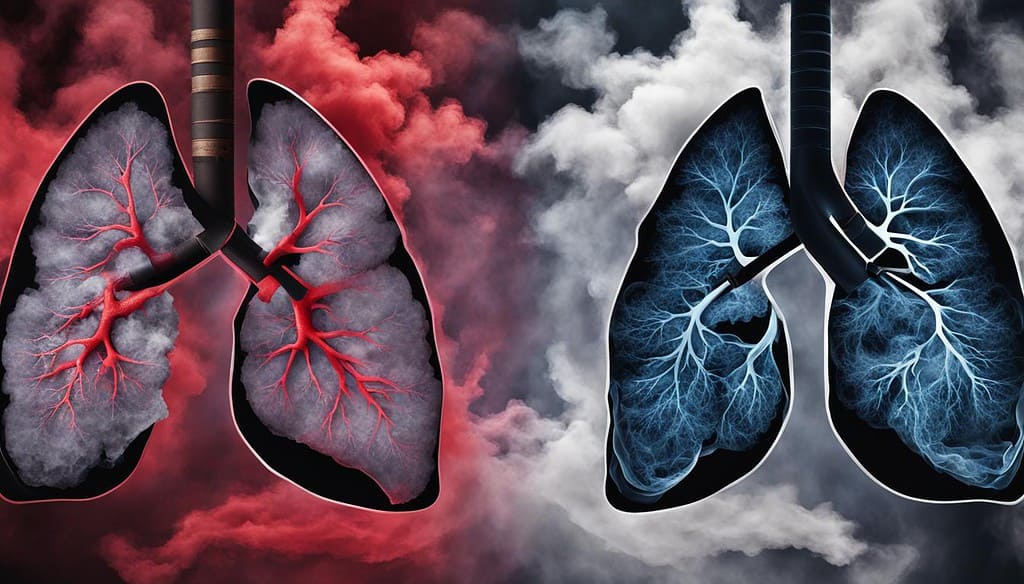Exploring the Benefits of Vaping vs. Smoking
Welcome to our comprehensive guide on the benefits of vaping compared to smoking. In this article, we will delve into the advantages of vaping, the positive effects it can have on smokers, and why many individuals choose to start vaping. Before we begin, it’s important to note that vaping and smoking both have risks and potential side effects. However, we will focus on highlighting the potential benefits of vaping over traditional cigarettes.
Vaping offers several health benefits, making it an attractive option for those looking to transition away from smoking. Unlike traditional cigarettes, vaping does not involve burning tobacco, which produces harmful chemicals and carcinogens. As a result, vaping is often considered less harmful to human health. Additionally, vaping allows users to customize their nicotine intake, making it easier to gradually reduce nicotine dependence.
One of the main advantages of using e-cigarettes is that they eliminate the risks associated with secondhand smoke. Vaping produces aerosol, commonly referred to as vapor, which dissipates quickly and does not contain the same harmful toxins found in cigarette smoke. This makes vaping a more considerate option for those around you, as well as reducing the risk of passive smoking-related health issues.
Furthermore, many smokers find vaping to be a helpful tool when attempting to quit smoking. Vaping can provide the same hand-to-mouth action and vaping sensation that smokers crave, while gradually reducing their nicotine intake. This controlled approach can ease the transition and increase the chances of successfully quitting smoking.
In upcoming sections, we will explore the risks associated with both vaping and smoking in more detail. The goal is to provide a comprehensive analysis of the potential health effects and the overall implications for public health. By having a better understanding of the benefits and risks, individuals can make informed decisions about their smoking habits and potentially improve their overall well-being.
Continue reading to discover the risks of vaping and the risks of smoking.
Table of Contents
The Risks of Vaping
Vaping exposes users to a variety of risks and dangers. E-cigarettes can contain high doses of nicotine, which can harm brain development in fetuses, children, and teenagers. The liquid used in vaping devices can be dangerous if swallowed, inhaled, or in contact with the skin. Vaping also delivers dangerous chemicals such as diacetyl, cancer-causing chemicals, heavy metals, and volatile organic compounds (VOCs). Vaping has been associated with severe lung injuries and deaths, particularly when using black market modified e-liquids or vaping products containing THC. The use of vitamin E acetate in vaping products has also been linked to lung injuries. Vaping can have negative effects on respiratory health, weaken the immune system, and potentially delay brain development in young individuals. Additionally, defective batteries in e-cigarettes can lead to explosions and burns.
“Vaping exposes users to high doses of nicotine and dangerous chemicals, increasing the risks to brain development, respiratory health, and overall well-being.”
In a study conducted by The New England Journal of Medicine, it was discovered that vaping can cause severe lung injury, leading to hospitalization and even death. The study revealed that many patients reported using e-cigarettes with THC, suggesting a connection between vaping and lung injuries. The use of vitamin E acetate, an additive found in some vaping products, has also been identified as a potential cause of lung injury.
The harmful effects of vaping extend beyond the respiratory system. The presence of nicotine in e-cigarettes can lead to addiction, especially among young individuals. The nicotine content in some vaping devices can be even higher than that of traditional cigarettes, making them highly addictive. Additionally, the chemicals found in e-cigarette vapor, such as diacetyl and cancer-causing chemicals, pose serious health risks.
A recent report published by the World Health Organization (WHO) highlighted the concerning increase in vaping among young people. The report emphasized the need for stricter regulations and increased awareness of the risks associated with vaping. Governments and health organizations around the world are urging individuals, especially young adults and adolescents, to refrain from using e-cigarettes due to the potential health hazards.
To better understand the risks of vaping, it is essential to analyze the harmful effects on specific aspects of health. Here is a breakdown of the negative effects of vaping:
| Health Risks of Vaping | Description |
|---|---|
| Respiratory Health | Vaping can lead to respiratory problems, including coughing, wheezing, and lung inflammation. Research suggests that inhaling the toxic chemicals present in e-cigarette vapor can cause long-term damage to the lungs. |
| Brain Development | Young individuals, including fetuses, children, and teenagers, are particularly vulnerable to the harmful effects of nicotine. Nicotine exposure during these critical stages of brain development can lead to long-lasting cognitive and behavioral impairments. |
| Immune System | Vaping can weaken the immune system, making individuals more susceptible to infections and respiratory illnesses. It can also impair the body’s ability to heal and recover from illnesses. |
| Explosions and Burns | Defective e-cigarettes and batteries can malfunction, leading to explosions and serious burn injuries. These incidents highlight the potential dangers associated with using vaping devices. |
It is crucial to be fully informed about the risks of vaping before considering it as an alternative to smoking. The emerging evidence of severe lung injuries, addiction potential, and other health risks emphasizes the need for caution. Consulting with healthcare professionals and exploring evidence-based smoking cessation methods might be a safer and more effective approach to improving overall health and well-being.
The Risks of Smoking
Smoking is a well-known health hazard and is associated with numerous risks and dangers. It causes damage to every organ in the body and is the leading cause of preventable deaths. The harmful effects of smoking include an increased risk of heart disease, lung cancer, and chronic obstructive pulmonary disease (COPD). It also raises the likelihood of developing other health conditions such as stroke and respiratory diseases.
“Smoking is the leading cause of preventable deaths.”
One of the main reasons smoking is highly addictive is due to the presence of nicotine. Nicotine addiction can lead to cravings and withdrawal symptoms, making it challenging to quit smoking. Unfortunately, the success rate of quitting smoking is low, highlighting the addictive nature of cigarettes.
“Smoking is highly addictive due to the presence of nicotine.”
It is essential to understand the negative effects of smoking when considering alternatives like vaping. Quitting smoking completely is the best option for improving overall health and reducing the associated risks.
Vaping vs. Smoking: A Health Comparison
When it comes to assessing the health impacts, vaping and smoking are often compared to determine the lesser evil. While the long-term effects of vaping are still being researched, it is generally agreed upon that vaping is less harmful than smoking. Vaping does not expose users to the same level of harmful chemicals found in tobacco smoke, such as tar and carbon monoxide.
However, it is important to note that vaping is not without its own risks. The inhalation of aerosol from e-cigarettes can have negative effects on respiratory health and overall well-being. Vaping has been associated with severe lung injuries and inflammation, especially when using black market modifications or products containing THC. The use of certain chemicals and substances in e-liquids, like diacetyl and volatile organic compounds, can have harmful effects on the lungs.
In contrast, smoking is a well-known health hazard that carries a multitude of risks and diseases. Smoking tobacco cigarettes exposes the user to a range of toxins and carcinogens, significantly increasing the likelihood of developing lung cancer, heart disease, and chronic respiratory conditions. The addictive nature of smoking makes it difficult to quit and further adds to its detrimental impact on health.
While vaping may present some benefits over smoking, it is crucial to emphasize that both activities carry risks. The best decision for one’s health is still to quit smoking entirely.
Comparing the Health Effects
| Factors | Vaping | Smoking |
|---|---|---|
| Chemical Exposure | Vaping involves inhaling an aerosol that contains chemicals, including nicotine and flavoring. It may expose users to lower levels of harmful chemicals compared to smoking. | Smoking tobacco cigarettes releases thousands of harmful chemicals, including nicotine, tar, carbon monoxide, and cancer-causing substances. |
| Respiratory Health | Vaping has been associated with lung injuries and respiratory problems, particularly when using counterfeit or modified vaping products. The long-term effects on lung health are still being studied. | Smoking damages lung function and increases the risk of various respiratory diseases, including lung cancer and chronic obstructive pulmonary disease (COPD). |
| Cardiovascular Health | Research on the impact of vaping on heart health is limited, but emerging data suggests potential associations between vaping and cardiovascular disease. More research is needed to fully understand the risks. | Smoking is a leading cause of heart disease, increasing the risk of heart attacks, stroke, and other cardiovascular conditions. |
| Addiction | Nicotine addiction can occur with vaping, especially among young people. However, the addictive potential may be lower compared to smoking. | Smoking is highly addictive due to the presence of nicotine, making quitting smoking a challenging task. |
While this comparison highlights some key differences between vaping and smoking, it is important to emphasize that quitting smoking entirely remains the best option for improving overall health. The decision to vape should be made after careful consideration of the potential risks and personalized advice from healthcare professionals.
Vaping as a Smoking Cessation Tool
Vaping has gained popularity as a potential tool to help smokers quit their tobacco habit. Some studies suggest that daily e-cigarette use can increase the likelihood of quitting smoking and achieving long-term smoking abstinence.
However, it is important to note that the effectiveness of vaping as a quitting tool is still a topic of debate. While some individuals have successfully used e-cigarettes to quit smoking, many people end up continuing to use both traditional cigarettes and e-cigarettes.
The limited evidence regarding the effectiveness of vaping for smoking cessation highlights the need for more research in this area. It is crucial to fully understand the role of vaping in helping individuals quit smoking and the potential risks involved.
Consult Healthcare Professionals for Personalized Advice
If you are considering using e-cigarettes to quit smoking, it is recommended to consult with healthcare professionals for personalized advice. They can provide guidance on the most effective smoking cessation methods and help you create a tailored quitting plan.
Every individual’s journey to quitting smoking is unique, and healthcare professionals can offer the support and resources necessary to increase your chances of success.
Remember, quitting smoking is a significant step towards improving your health and well-being. While vaping may have its potential benefits, it is essential to explore all available options and make an informed decision that suits your individual needs and circumstances.
| Evidence-based Methods for Smoking Cessation | Benefits |
|---|---|
| Behavioral counseling or therapy | Addresses smoking triggers and provides coping strategies |
| Nicotine replacement therapy (NRT) | Eases nicotine withdrawal symptoms |
| Prescription medications | Helps reduce cravings and withdrawal symptoms |
| Support groups | Provides a network of individuals going through the same journey |
Addictive Properties of Smoking and Vaping

Nicotine, a highly addictive substance, is present in both smoking and vaping. Quitting nicotine addiction is challenging, with a low success rate. Research suggests that nicotine-containing e-cigarettes may have a higher addiction potential than standard cigarettes, particularly among young adults.
“Nicotine addiction is a powerful force that can make quitting smoking or vaping difficult.”
“I tried multiple times to quit smoking, but the addictive properties of nicotine made it incredibly tough. Vaping seemed like a healthier alternative, but I soon found myself facing the same struggle to quit vaping.” – Mark, former smoker and vaper
It is important to be aware of the addictive properties of both smoking and vaping when considering options to quit smoking. While vaping can be used as a harm reduction strategy, it is essential to work towards complete nicotine cessation for long-term health benefits.
Vaping and the Next Generation
Vaping has gained immense popularity among young people and has surpassed traditional smoking in terms of its appeal. The availability of flavored e-cigarettes, lower costs compared to traditional cigarettes, and the absence of smoke make vaping attractive to the youth.
However, concerns have been raised about the impact of vaping on the next generation. It is feared that vaping may not only lead to nicotine addiction but also serve as a gateway for young individuals to start smoking traditional tobacco products.
In order to safeguard the health and well-being of children and adolescents, it is crucial to implement effective strategies that prevent and discourage vaping among them.
By raising awareness about the potential risks associated with vaping and enhancing education on the matter, we can empower young people to make informed decisions and avoid the harmful effects of this practice.
| Concerns about Youth Vaping | Impact of Vaping on Young People |
|---|---|
| 1. Nicotine addiction in adolescents | 1. Increased risk of nicotine addiction |
| 2. Gateway to smoking traditional tobacco products | 2. Potential for initiating smoking habits |
| 3. Adverse effects on brain development | 3. Possible harm to cognitive development |
| 4. Influence on peer groups and social acceptance | 4. Impact on social dynamics and normalization of vaping |
It is our collective responsibility to protect the younger generation from the harms of vaping. By addressing these concerns and implementing preventive measures, we can ensure a healthier future for our youth.
Vaping and Lung Health

Vaping has been associated with severe lung injuries, as evidenced by the outbreak of EVALI (e-cigarette or vaping use-associated lung injury). Inhalation of chemicals present in e-cigarette vapor can lead to cytotoxicity, neutrophilic inflammation, and lung disease. The use of vitamin E acetate in vaping products has been linked to lung injuries. Vaping can also cause pre-symptomatic cardiovascular dysfunction and exposure to harmful substances. The long-term effects of vaping on lung health are still being researched, and it is important to consider the potential risks to respiratory health when deciding to vape.
Risks Associated with Vaping
When it comes to the impact of vaping on lungs, research has shown that there are respiratory risks involved. The inhalation of e-cigarette vapor can introduce harmful chemicals into the lungs, leading to inflammation and damage. Chemicals such as formaldehyde, acrolein, and volatile organic compounds (VOCs) have been found in e-cigarette aerosol, posing a potential threat to respiratory health.
Vaping can also lead to lung injuries, as seen in cases of EVALI. This condition is characterized by symptoms such as cough, shortness of breath, chest pain, and fever, and can progress to severe respiratory distress. The outbreak of EVALI highlighted the need for further investigation into the effects of vaping on lung health.
Health Risks of Vaping
Exposure to harmful substances through vaping can have detrimental effects on the lungs. The inhalation of toxic chemicals can cause damage to epithelial cells in the respiratory system, leading to inflammation and impaired lung function. Prolonged vaping can increase the risk of developing lung diseases such as chronic bronchitis and popcorn lung.
E-cigarette aerosol contains harmful substances that can negatively impact lung health, leading to inflammation, lung disease, and impaired respiratory function.
Lung Injuries Associated with Vaping
Vaping has been linked to cases of severe lung injuries, particularly when using black market modified e-liquids or products containing THC. The addition of vitamin E acetate in some vaping products has also been associated with lung injuries. These incidents emphasize the importance of being cautious when choosing and using vaping products.
A definitive understanding of the long-term effects of vaping on lung health is still evolving. Continued research is necessary to fully comprehend the respiratory risks associated with vaping and to develop strategies to reduce potential harm to the lungs.
| Impact of Vaping on Lungs | Respiratory Risks of Vaping | Lung Injuries Associated with Vaping |
|---|---|---|
| Introduction of harmful chemicals | Exposure to toxic substances | Severe lung injuries |
| Inflammation and damage to lung cells | Impaired respiratory function | Black market and THC-related incidents |
| Increased risk of lung diseases | Development of lung diseases | Concerns with vitamin E acetate |
Vaping and Heart Health
Emerging data suggests possible links between vaping and chronic lung disease, as well as associations between dual use of e-cigarettes and smoking with cardiovascular disease. The inhalation of harmful substances found in e-cigarette vapor, such as diacetyl and acrolein, can contribute to lung injury and COPD, which in turn can affect heart health. While more research is needed to fully understand the impact of vaping on heart health, it is important to be aware of the potential cardiovascular risks associated with vaping.
Public Health Implications of Vaping
The rise in popularity of vaping has raised significant public health concerns. E-cigarette companies have been accused of targeting young adults and adolescents through various marketing tactics. The increased use of e-cigarettes among young people, combined with the potential health risks of vaping, calls for immediate action to protect public health.
Regulation of vaping products is necessary to mitigate the potential negative impact of vaping on public health. This includes implementing appropriate warnings and restrictions on marketing to young people. By establishing strict regulations, governments can ensure that vaping products are manufactured and marketed responsibly, taking into consideration the health and well-being of consumers.
Vaping has the potential to be a helpful tool for smokers looking to quit traditional cigarettes. However, without proper regulation, it can also become a gateway to nicotine addiction for young individuals who may not have otherwise started smoking. It is crucial to prioritize public health by implementing comprehensive regulations that address the concerns and risks associated with vaping.
The Impact of Vaping on Public Health
Vaping has the potential to impact public health in several ways:
- Increased nicotine addiction: The popularity of vaping, particularly among young people, can lead to an increase in nicotine addiction. Nicotine is highly addictive and can have significant effects on brain development in adolescents.
- Normalizing smoking: The widespread availability and promotion of vaping products can normalize the act of smoking, potentially leading to an increase in smoking rates among the youth.
- Lack of long-term data: The long-term health effects of vaping are still not fully understood. It is important to conduct further research to fully comprehend the potential risks and benefits of vaping on public health.
Regulation of Vaping Products
Effective regulation of vaping products plays a crucial role in protecting public health. It ensures that the manufacturing, marketing, and sale of vaping products comply with safety standards and do not target vulnerable populations, such as young adults and adolescents.
Regulatory measures may include:
- Health warnings: Clear and prominent warnings about the potential risks of vaping should be displayed on packaging and marketing materials.
- Age restrictions: Strict age verification processes and regulations should be in place to prevent the sale of vaping products to minors.
- Marketing restrictions: Limitations on advertising and promotional activities targeting young people can help reduce the appeal and accessibility of vaping products.
- Product standards: Implementing quality control measures ensures that vaping products meet safety standards and do not contain harmful substances.
By regulating vaping products effectively, governments can protect public health, reduce potential harm, and promote responsible use of vaping as a smoking cessation tool.
Conclusion
While vaping may be considered a potentially less harmful alternative to smoking, it is crucial to understand the associated risks. Vaping has been touted as a potential tool to aid in smoking cessation, but its effectiveness is still a topic of debate. It is important to be aware of the potential health risks linked to vaping, including respiratory harm and nicotine addiction.
Public health initiatives should prioritize preventing youth initiation of vaping and promoting evidence-based methods for smoking cessation. Quitting smoking altogether remains the best course of action for improving overall health and well-being.
As the popularity of vaping continues to rise, it is critical to address the public health implications. Regulations on vaping products, including appropriate warnings and restrictions on marketing to young individuals, are necessary to safeguard the public’s health. By focusing on prevention and promoting quit smoking strategies, we can mitigate the potential negative impact of vaping on public health.
FAQ
What are the benefits of vaping compared to smoking?
Vaping is believed to be less harmful than smoking as it does not expose users to the same level of harmful chemicals. However, it is important to note that both vaping and smoking carry risks and can have negative effects on health.
What are the risks of vaping?
Vaping exposes users to various risks, including nicotine addiction, exposure to dangerous chemicals, potential harm to the lungs, immune system, and brain development in fetuses, children, and teenagers. It can also lead to severe lung injuries and other negative respiratory effects.
What are the risks of smoking?
Smoking is a well-known health hazard that can cause damage to every organ in the body and is the leading cause of preventable deaths. It is associated with numerous diseases and conditions, including heart disease, lung cancer, and chronic obstructive pulmonary disease (COPD).
How does vaping compare to smoking in terms of health effects?
While the long-term health effects of vaping are still being studied, it is generally believed that vaping is less harmful than smoking. Vaping does not expose users to the same level of harmful chemicals found in tobacco smoke. However, both vaping and smoking carry risks and quitting smoking entirely is the best option for improving health.
Can vaping help with smoking cessation?
Vaping has been promoted as a tool to help smokers quit their tobacco habit, and some studies suggest that it can increase the likelihood of quitting smoking. However, its effectiveness as a quitting tool is still a topic of debate, and more research is needed to fully understand its role in smoking cessation.
Are smoking and vaping both addictive?
Yes, nicotine, a highly addictive substance, is present in both smoking and vaping. Quitting nicotine addiction is challenging, and research suggests that nicotine-containing e-cigarettes may have a higher addiction potential than standard cigarettes.
What are the concerns about vaping and the next generation?
Vaping has become increasingly popular among young people, and there are concerns about its impact on the next generation. It may lead to nicotine addiction and serve as a gateway to smoking traditional tobacco products. Efforts should be made to prevent and discourage vaping among children and adolescents to protect their health and well-being.
How does vaping affect lung health?
Vaping has been associated with severe lung injuries and can have negative effects on respiratory health. The inhalation of chemicals present in e-cigarette vapor can lead to lung disease, and the use of certain substances in vaping products has been linked to lung injuries.
Does vaping have an impact on heart health?
The impact of vaping on heart health is still being researched. However, there are possible links between vaping and chronic lung disease as well as associations between dual use of e-cigarettes and smoking with cardiovascular disease. The inhalation of harmful substances in e-cigarette vapor can contribute to lung injury, which can affect heart health.
What are the public health implications of vaping?
The rise in vaping popularity has raised significant public health concerns. Efforts should be made to regulate vaping products, including appropriate warnings and restrictions on marketing to young people, to mitigate potential negative impacts on public health.
What is the conclusion regarding vaping and smoking?
Vaping is believed to be less harmful than smoking, but it is not without risks. Both vaping and smoking carry health risks, and quitting smoking entirely is the best option for improving overall health. Public health efforts should focus on preventing youth initiation of vaping and promoting evidence-based methods for smoking cessation.







